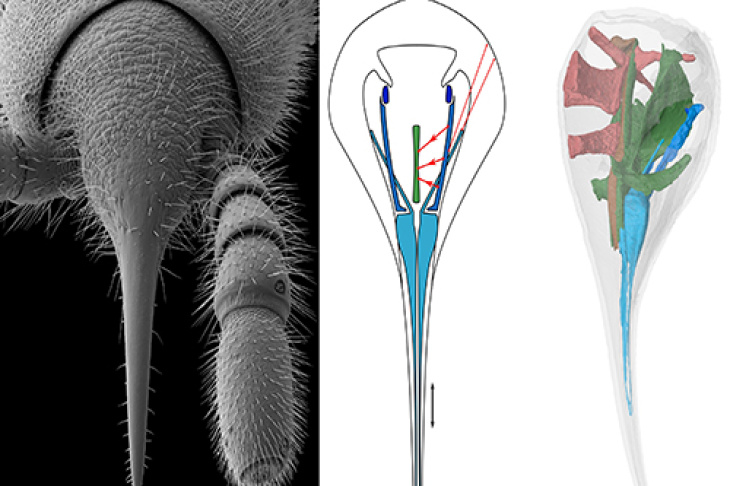Liquid food available to centipedes
A team led by the Leibniz Institute for the Analysis of Biodiversity Change and the University of Bonn in cooperation with Jörg Hammel from the Helmholtz-Zentrum Hereon showed that millipedes subsist from liquid food as well. The research team inspected the heads of individuals of Colobognatha ([Colobus, Greek gnathos = the jaw], millipedes) and found a suction pump for ingesting liquid food. The study recently appeared in the journal Science Advances.

X-ray microtomography images of the suction pump [Photo: Hereon/ Jörg U. Hammel]
The fact that butterflies love to sip nectar and mosquitoes love our blood is nothing new. The same applies to plenty of other insects and arthropods. Millipedes belong to the diverse group of arthropods, which also includes insects, crustaceans and arachnids. In the context of the latter, the ingestion of liquid food has already been well researched. It is astonishing that a suction pump has now also been discovered in millipedes. Which additionally shows very similar biomechanical approaches to the intake of liquid food as those of various groups of organisms, some of which are rather distanced. The discovery confirms previous scientific assumptions. The suction pump is the result of independent evolution for over 100 million years.
All of the nine examined millipedes species have a similar sucking pump to that of insects. The team was thus able to reveal that the functional sucking organs in all major subgroups of arthropods have developed several times independently of each other, as the press release of the Leibniz Institute for the Analysis of Biodiversity Change states.
Dr. Jörg Hammel from the Helmholtz-Zentrum Hereon provided X-ray microtomography images with elevated resolution. Produced with the Hereon instruments at the Speicherring PETRA III of the Deutschen Elektronen-Synchrotrons DESY Hamburg: "You receive a 3D image data set just like a CT-examination in the clinic. In contrast to the clinic, we can achieve a higher resolution and use special contrast techniques. Using the 3D data, the colleagues in Bonn were able to reconstruct the anatomy of the centipede's feeding apparatus and set up a model of how it works," explains Hammel.
Why the lack of millipedes species?
Compared to the diverse group of sucking insects with over 400,000 species, the group of Colobognatha millipedes contains only 250 species. Why is that? Prof Alexander Blanke, a lead author of the study from the University of Bonn assumes that: "Today's sucking millipedes are probably a relict group and the remnant of a once much larger diversity." Since millipedes cannot fly, their dispersal and migration possibilities are limited. In addition, their habitat is predominantly reduced to humid biospheres, which makes them, in contrast to flying insects, significantly more susceptible to environmental changes. In this respect, the study provides insights into the development of biodiversity and facilitates its understanding.
The message is adapted from the press release of the Leibniz Institute for the Analysis of Biodiversity Change and the University of Bonn.
Further Information
- Press release of the Leibniz-Institut zur Analyse des Biodiversitätswandels
- Website Institute of Materials Research, Materials Physics, Dept. "X-ray Imaging with Synchrotron Radiation“
- Original publication Moritz L., Borisova E., Hammel J.U., Blanke A., Wesener T. (2022) A previously unknown feeding mode in millipedes and the convergence of fluid feeding across arthropods. Science Advances, Volume 8, Issue 7
doi: 10.1126/sciadv.abm0577
Contact
Institute of Materials Research, Materials Physics, Dept. "X-ray Imaging with Synchrotron Radiation“ at DESY Hamburg
Helmholtz-Zentrum Hereon
Communication and Media
Helmholtz-Zentrum Hereon
